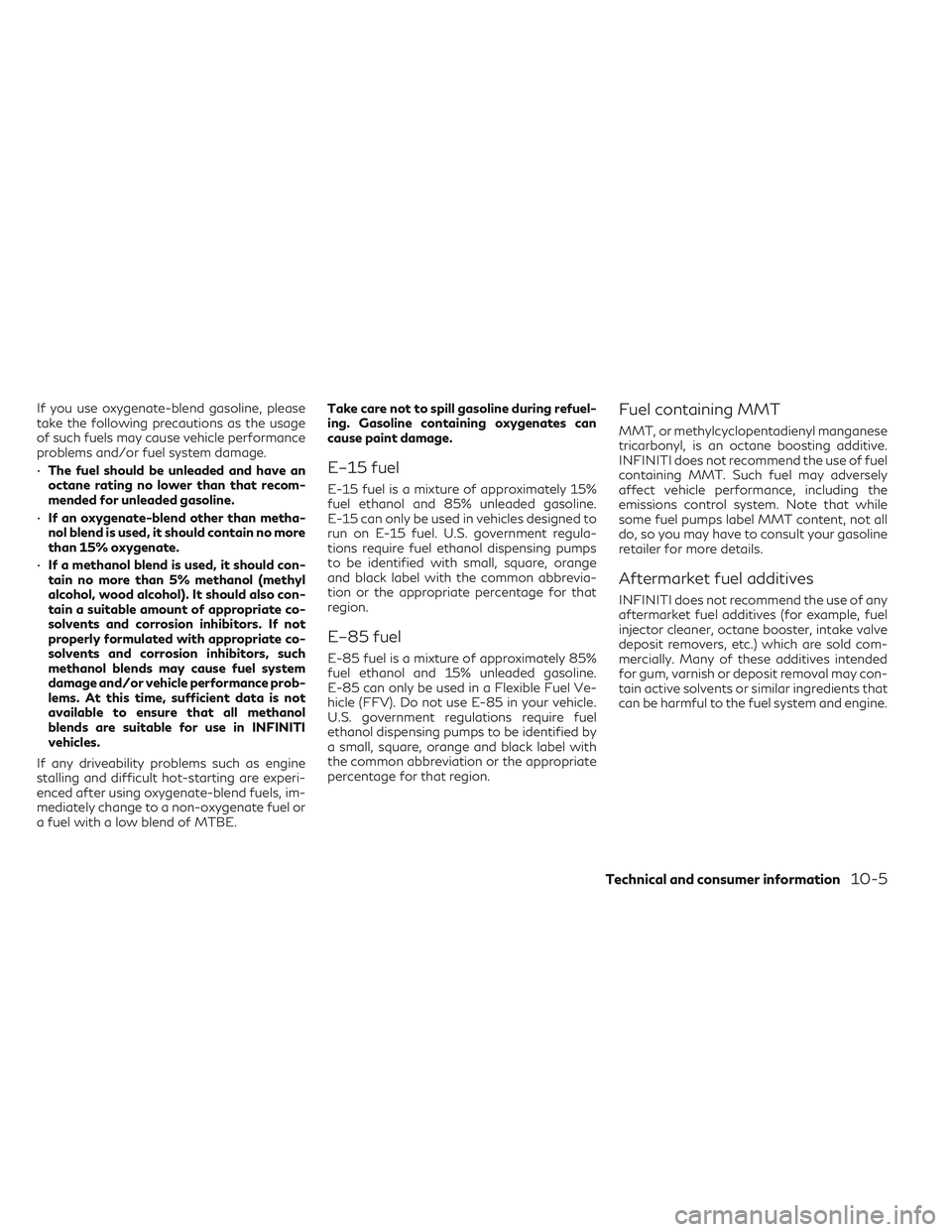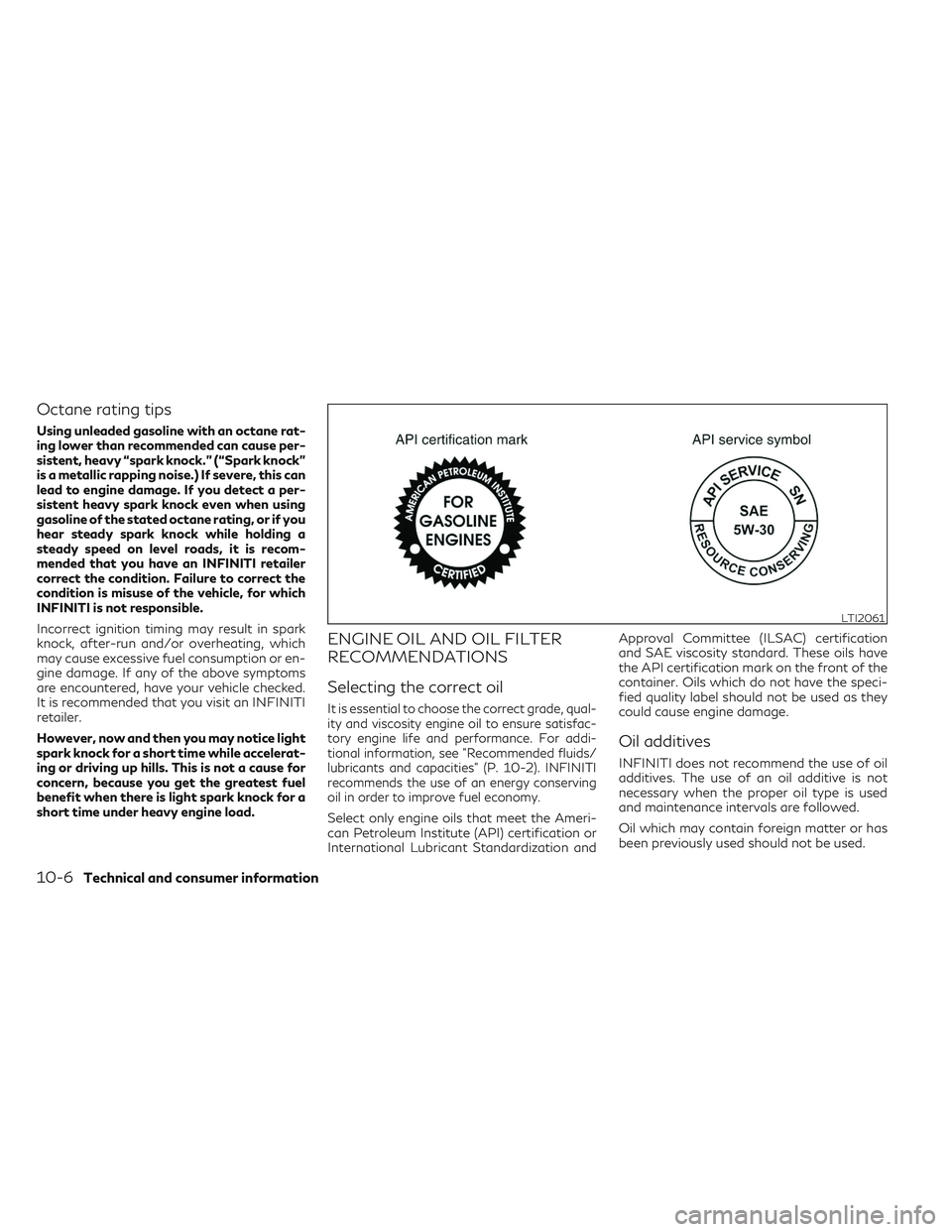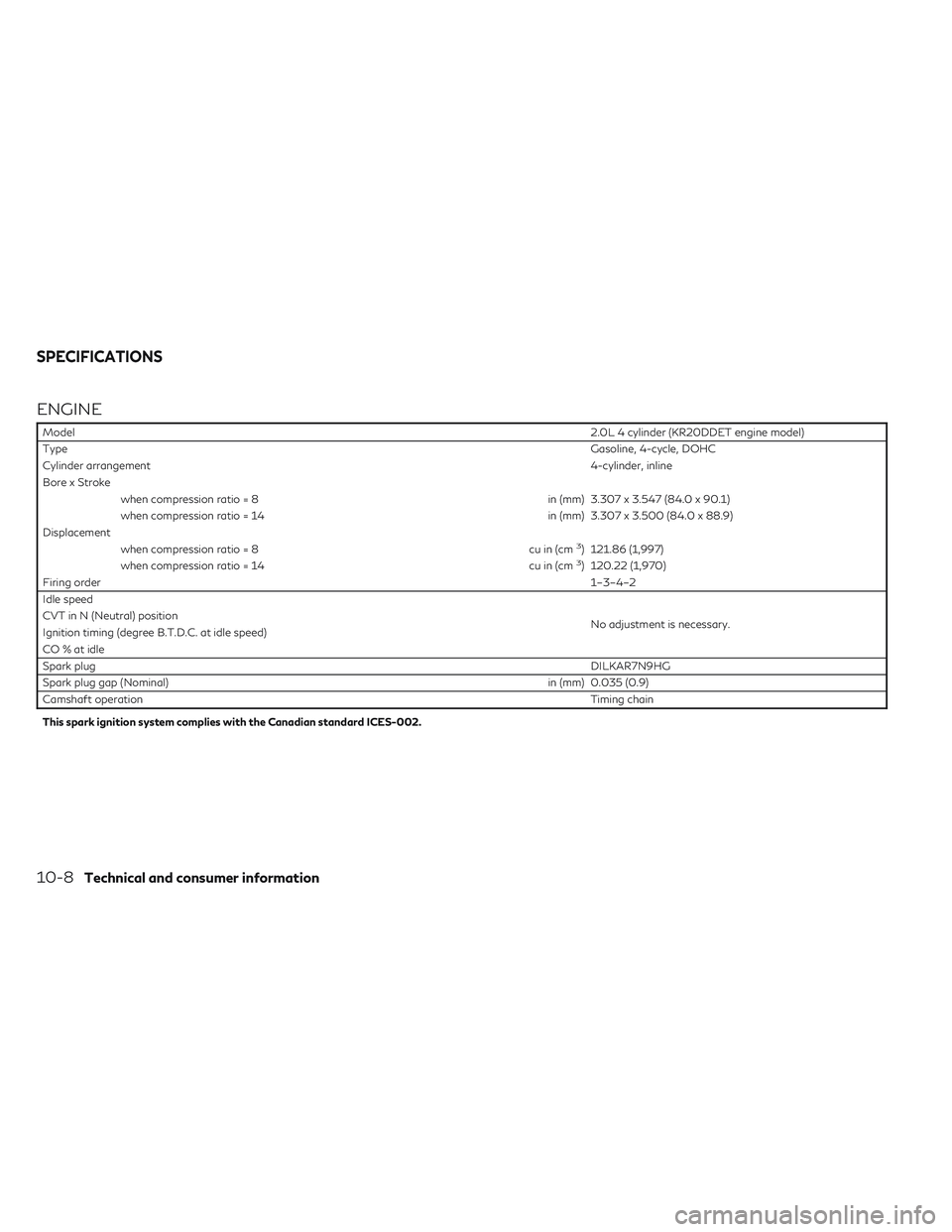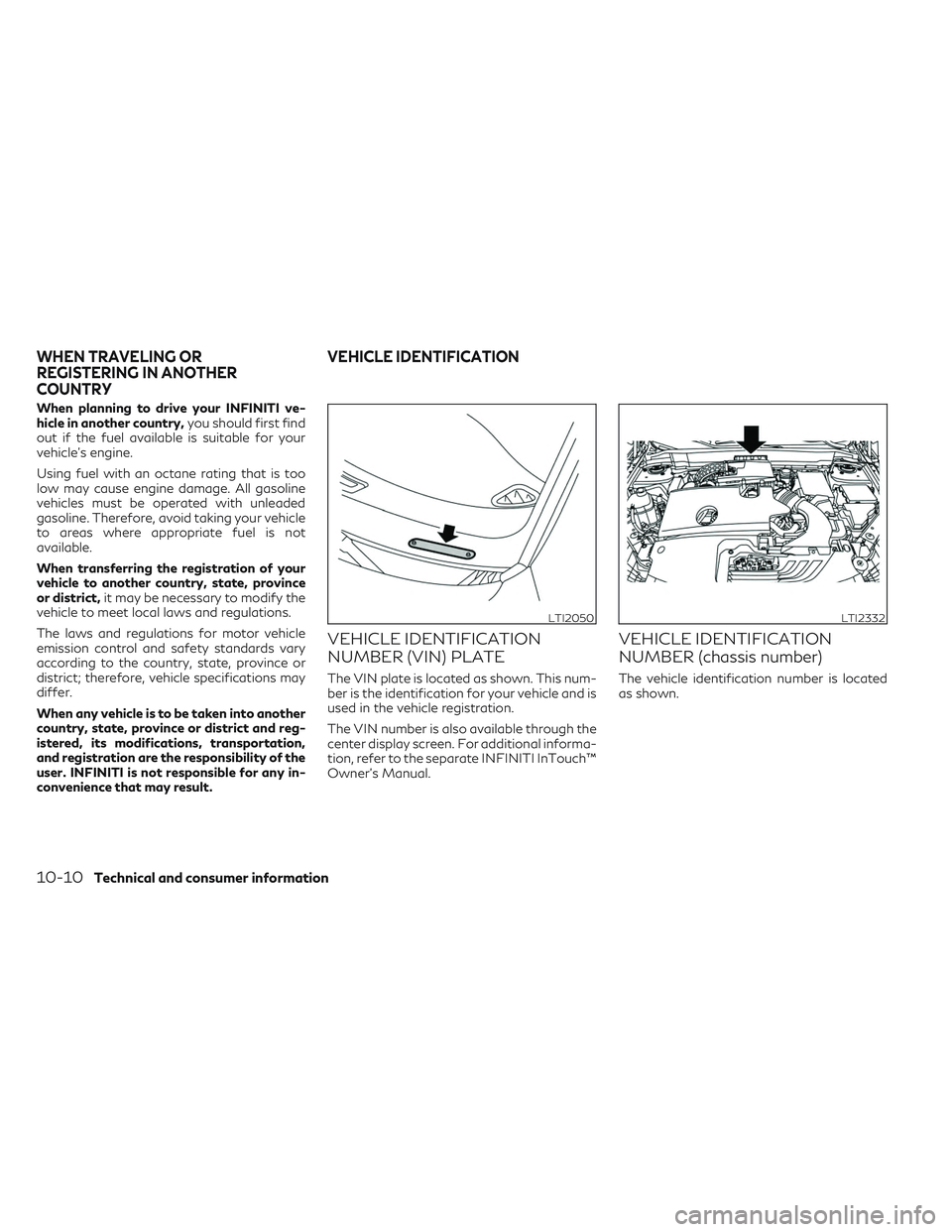engine INFINITI QX50 2022 Owners Manual
[x] Cancel search | Manufacturer: INFINITI, Model Year: 2022, Model line: QX50, Model: INFINITI QX50 2022Pages: 540, PDF Size: 6.58 MB
Page 495 of 540

If you use oxygenate-blend gasoline, please
take the following precautions as the usage
of such fuels may cause vehicle performance
problems and/or fuel system damage.
•The fuel should be unleaded and have an
octane rating no lower than that recom-
mended for unleaded gasoline.
• If an oxygenate-blend other than metha-
nol blend is used, it should contain no more
than 15% oxygenate.
• If a methanol blend is used, it should con-
tain no more than 5% methanol (methyl
alcohol, wood alcohol). It should also con-
tain a suitable amount of appropriate co-
solvents and corrosion inhibitors. If not
properly formulated with appropriate co-
solvents and corrosion inhibitors, such
methanol blends may cause fuel system
damage and/or vehicle performance prob-
lems. At this time, sufficient data is not
available to ensure that all methanol
blends are suitable for use in INFINITI
vehicles.
If any driveability problems such as engine
stalling and difficult hot-starting are experi-
enced after using oxygenate-blend fuels, im-
mediately change to a non-oxygenate fuel or
a fuel with a low blend of MTBE. Take care not to spill gasoline during refuel-
ing. Gasoline containing oxygenates can
cause paint damage.
E–15 fuel
E-15 fuel is a mixture of approximately 15%
fuel ethanol and 85% unleaded gasoline.
E-15 can only be used in vehicles designed to
run on E-15 fuel. U.S. government regula-
tions require fuel ethanol dispensing pumps
to be identified with small, square, orange
and black label with the common abbrevia-
tion or the appropriate percentage for that
region.
E–85 fuel
E-85 fuel is a mixture of approximately 85%
fuel ethanol and 15% unleaded gasoline.
E-85 can only be used in a Flexible Fuel Ve-
hicle (FFV). Do not use E-85 in your vehicle.
U.S. government regulations require fuel
ethanol dispensing pumps to be identified by
a small, square, orange and black label with
the common abbreviation or the appropriate
percentage for that region.
Fuel containing MMT
MMT, or methylcyclopentadienyl manganese
tricarbonyl, is an octane boosting additive.
INFINITI does not recommend the use of fuel
containing MMT. Such fuel may adversely
affect vehicle performance, including the
emissions control system. Note that while
some fuel pumps label MMT content, not all
do, so you may have to consult your gasoline
retailer for more details.
Aftermarket fuel additives
INFINITI does not recommend the use of any
aftermarket fuel additives (for example, fuel
injector cleaner, octane booster, intake valve
deposit removers, etc.) which are sold com-
mercially. Many of these additives intended
for gum, varnish or deposit removal may con-
tain active solvents or similar ingredients that
can be harmful to the fuel system and engine.
Technical and consumer information10-5
Page 496 of 540

Octane rating tips
Using unleaded gasoline with an octane rat-
ing lower than recommended can cause per-
sistent, heavy “spark knock.” (“Spark knock”
is a metallic rapping noise.) If severe, this can
lead to engine damage. If you detect a per-
sistent heavy spark knock even when using
gasoline of the stated octane rating, or if you
hear steady spark knock while holding a
steady speed on level roads, it is recom-
mended that you have an INFINITI retailer
correct the condition. Failure to correct the
condition is misuse of the vehicle, for which
INFINITI is not responsible.
Incorrect ignition timing may result in spark
knock, after-run and/or overheating, which
may cause excessive fuel consumption or en-
gine damage. If any of the above symptoms
are encountered, have your vehicle checked.
It is recommended that you visit an INFINITI
retailer.
However, now and then you may notice light
spark knock for a short time while accelerat-
ing or driving up hills. This is not a cause for
concern, because you get the greatest fuel
benefit when there is light spark knock for a
short time under heavy engine load.
ENGINE OIL AND OIL FILTER
RECOMMENDATIONS
Selecting the correct oil
It is essential to choose the correct grade, qual-
ity and viscosity engine oil to ensure satisfac-
tory engine life and performance. For addi-
tional information, see "Recommended fluids/
lubricants and capacities" (P. 10-2). INFINITI
recommends the use of an energy conserving
oil in order to improve fuel economy.
Select only engine oils that meet the Ameri-
can Petroleum Institute (API) certification or
International Lubricant Standardization andApproval Committee (ILSAC) certification
and SAE viscosity standard. These oils have
the API certification mark on the front of the
container. Oils which do not have the speci-
fied quality label should not be used as they
could cause engine damage.
Oil additives
INFINITI does not recommend the use of oil
additives. The use of an oil additive is not
necessary when the proper oil type is used
and maintenance intervals are followed.
Oil which may contain foreign matter or has
been previously used should not be used.
LTI2061
10-6Technical and consumer information
Page 497 of 540

Oil viscosity
The engine oil viscosity or thickness changes
with temperature. Because of this, it is impor-
tant to select the engine oil viscosity based on
the temperatures at which the vehicle will be
operated before the next oil change. Choos-
ing an oil viscosity other than that recom-
mended could cause serious engine damage.
Selecting the correct oil filter
Your new INFINITI vehicle is equipped with a
high-quality Genuine NISSAN oil filter. When
replacing, use a Genuine NISSAN oil filter or
its equivalent for the reason described in
“Change intervals”.
Change intervals
The oil and oil filter change intervals for your
engine are based on the use of the specified
quality oils and filters. Using engine oil and
filters that are not of the specified quality, or
exceeding recommended oil and filter change
intervals could reduce engine life.
CAUTION
Damage to engine caused by improper main-
tenance or use of incorrect oil and filter qual-
ity and/or viscosity is not covered by the
INFINITI New Vehicle Limited Warranty.
Your engine was filled with a high-quality
engine oil when it was built. You do not have
to change the oil before the first recom-
mended change interval. Oil and filter change
intervals depend upon how you use your
vehicle.
Operation under the following conditions
may require more frequent oil and filter
changes:
• repeated short distance driving at cold out-side temperatures
• driving in dusty conditions
• extensive idling
• towing a trailer
• stop and go commuting
For additional information on maintenance
schedules, see “Maintenance and schedules”
(P. 9-2).
AIR CONDITIONER SYSTEM
REFRIGERANT AND OIL
RECOMMENDATIONS
The air conditioner system in your INFINITI
vehicle must be charged with the refrigerant
HFO-1234yf (R-1234yf) and the oil,
Genuine NISSAN A/C System Oil Type PAG
(ND-OIL12) or the exact equivalents.
CAUTION
The use of any other refrigerant or oil will
cause severe damage to the air condition-
ing system and will require the replacement
of all air conditioner system components.
The refrigerant HFO-1234yf (R-1234yf) in
your INFINITI vehicle does not harm the
earth's ozone layer. Although this refrigerant
does not affect the earth's atmosphere, cer-
tain government regulations require the re-
covery and recycling of any refrigerant during
automotive air conditioner system service. Air
conditioner system should only be serviced by
trained and certified technicians to ensure
proper and safe operation (SAE J2845). An
INFINITI retailer has the trained technicians
and equipment needed to recover and recycle
your air conditioner system refrigerant. Only
new and SAEJ2842 certified evaporator(s)
shall be used as replacement parts.
A damaged or leaking air conditioning evapo-
rator shall never be repaired or replaced with
one removed from a used or salvaged vehicle.
To replace a damaged or leaking evaporator,
use only new and SAE J2842 certified
evaporator(s). It is recommended that you
visit an INFINITI retailer when servicing your
air conditioner system.
Technical and consumer information10-7
Page 498 of 540

ENGINE
Model2.0L 4 cylinder (KR20DDET engine model)
Type Gasoline, 4-cycle, DOHC
Cylinder arrangement 4-cylinder, inline
Bore x Stroke when compression ratio = 8 in (mm) 3.307 x 3.547 (84.0 x 90.1)
when compression ratio = 14 in (mm) 3.307 x 3.500 (84.0 x 88.9)
Displacement when compression ratio = 8 cu in (cm
3) 121.86 (1,997)
when compression ratio = 14 cu in (cm3) 120.22 (1,970)
Firing order 1–3–4–2
Idle speed
No adjustment is necessary.
CVT in N (Neutral) position
Ignition timing (degree B.T.D.C. at idle speed)
CO%atidle
Spark plug
DILKAR7N9HG
Spark plug gap (Nominal) in (mm) 0.035 (0.9)
Camshaft operation Timing chain
This spark ignition system complies with the Canadian standard ICES-002.
SPECIFICATIONS
10-8Technical and consumer information
Page 500 of 540

When planning to drive your INFINITI ve-
hicle in another country,you should first find
out if the fuel available is suitable for your
vehicle's engine.
Using fuel with an octane rating that is too
low may cause engine damage. All gasoline
vehicles must be operated with unleaded
gasoline. Therefore, avoid taking your vehicle
to areas where appropriate fuel is not
available.
When transferring the registration of your
vehicle to another country, state, province
or district, it may be necessary to modify the
vehicle to meet local laws and regulations.
The laws and regulations for motor vehicle
emission control and safety standards vary
according to the country, state, province or
district; therefore, vehicle specifications may
differ.
When any vehicle is to be taken into another
country, state, province or district and reg-
istered, its modifications, transportation,
and registration are the responsibility of the
user. INFINITI is not responsible for any in-
convenience that may result.
VEHICLE IDENTIFICATION
NUMBER (VIN) PLATE
The VIN plate is located as shown. This num-
ber is the identification for your vehicle and is
used in the vehicle registration.
The VIN number is also available through the
center display screen. For additional informa-
tion, refer to the separate INFINITI InTouch™
Owner's Manual.
VEHICLE IDENTIFICATION
NUMBER (chassis number)
The vehicle identification number is located
as shown.
LTI2050LTI2332
WHEN TRAVELING OR
REGISTERING IN ANOTHER
COUNTRY VEHICLE IDENTIFICATION
10-10Technical and consumer information
Page 501 of 540

ENGINE SERIAL NUMBER
The number is stamped on the engine as
shown.
F.M.V.S.S./C.M.V.S.S.
CERTIFICATION LABEL
The Federal/Canadian Motor Vehicle Safety
Standard (F.M.V.S.S./C.M.V.S.S.) certifica-
tion label is affixed as shown. This label con-
tains valuable vehicle information, such as:
(GVWR), (GAWR), month and year of manu-
facture, (VIN), etc. Review it carefully.
EMISSION CONTROL
INFORMATION LABEL
The emission control information label is at-
tached to the underside of the hood as
shown.
LTI2328WTI0172WTI0188
Technical and consumer information10-11
Page 509 of 540

MEASUREMENT OF WEIGHTS
Secure loose items to prevent weight
shifts that could affect the balance of
your vehicle. When the vehicle is
loaded, drive to a scale and weigh the
front and the rear wheels separately
to determine axle loads. Individual axle
loads should not exceed either of the
Gross Axle Weight Ratings (GAWR).
The total of the axle loads should not
exceed the Gross Vehicle Weight Rat-
ing (GVWR). These ratings are given
on the vehicle certification label. If
weight ratings are exceeded, move or
remove items to bring all weights be-
low the ratings.
Tow Hitch Receiver (with Tow Package)
WARNING
Overloading or improper loading of a
trailer and its cargo can adversely affect
vehicle handling, braking and performance
and may lead to accidents.
CAUTION
• Do not tow a trailer or haul a heavy load
for the first 500 miles (805 km). Your
engine, axle or other parts could be
damaged.
• For the first 500 miles (805 km) that you
tow a trailer, do not drive over 50 mph
(80 km/h) and do not make starts at full
throttle. This helps the engine and other
parts of your vehicle wear in at the
heavier loads.
NOTE:
Tow hitches are available as an accessory for
this vehicle. If a tow hitch is installed, the
liftgate electronic control unit (ECU) needs
to be replaced with an ECU programmed
with towing logic for the Motion-Activated
Liftgate to function properly.
Your new vehicle was designed to be used
primarily to carry passengers and cargo. Re-
member that towing a trailer places addi-
tional loads on your vehicle's engine, drive
train, steering, braking and other systems.
An INFINITI Towing Guide (U.S. only) is avail-
able on the website at www.InfinitiUSA.com.
This guide includes information on trailer tow-
ing capability and the special equipment re-
quired for proper towing.
LTI2339
TOWING A TRAILER
Technical and consumer information10-19
Page 511 of 540

can affect engine performance and cause
overheating. The engine protection mode,
which helps reduce the chance of engine
damage, could activate and automatically
decrease engine power. Vehicle speed may
decrease under high load. Plan your trip care-
fully to account for trailer and vehicle load,
weather and road conditions.
WARNING
Overheating can result in reduced engine
power and vehicle speed. The reduced
speed may be lower than other traffic,
which could increase the chance of a colli-
sion. Be especially careful when driving. If
the vehicle cannot maintain a safe driving
speed, pull to the side of the road in a safe
area. Allow the engine to cool and return to
normal operation. For additional informa-
tion, see “If your vehicle overheats”
(P. 6-7)
CAUTION
Vehicle damage resulting from improper
towing procedures is not covered by
INFINITI warranties.
Tongue load
When using a weight carrying or a weight
distributing hitch, keep the tongue load be-
tween 10 - 15% of the total trailer load or use
the trailer tongue load specified by the trailer
manufacturer. The tongue load must be
within the maximum tongue load limits
shown in the following “Towing Load/
Specification” chart. If the tongue load be-
comes excessive, rearrange cargo to allow
for proper tongue load.
Maximum Gross Vehicle Weight
(GVW)/maximum Gross Axle
Weight (GAW)
The GVW of the towing vehicle must not
exceed the Gross Vehicle Weight Rating
(GVWR) shown on the F.M.V.S.S./C.M.V.S.S.
certification label. The GVW equals the com-
bined weight of the unloaded vehicle, pas-
sengers, luggage, hitch, trailer tongue load
and any other optional equipment. In addi-
tion, front or rear GAW must not exceed the
Gross Axle Weight Rating (GAWR) shown on
the F.M.V.S.S./C.M.V.S.S. certification label.
WTI0160LTI2031
Technical and consumer information10-21
Page 517 of 540

• Check your hitch, trailer tire pressure, ve-hicle tire pressure, trailer light operation,
and trailer wheel lug nuts every time you
attach a trailer to the vehicle.
• Be certain your rearview mirrors conform to all federal, state or local regulations. If
not, install any mirrors required for towing
before driving the vehicle.
• Determine the overall height of the vehicle and trailer so the required clearance is
known.
Trailer towing tips
In order to gain skill and an understanding of
the vehicle's behavior, you should practice
turning, stopping and backing up in an area
which is free from traffic. Steering stability
and braking performance will be somewhat
different than under normal driving
conditions.
• Always secure items in the trailer to preventload shift while driving.
• Lock the trailer hitch coupler with a pin or lock to prevent the coupler from inadver-
tently becoming unlatched.
• Avoid abrupt starts, acceleration or stops.
• Avoid sharp turns or lane changes.
• Always drive your vehicle at a moderate speed. • When backing up, hold the bottom of the
steering wheel with one hand. Move your
hand in the direction in which you want the
trailer to go. Make small corrections and
back up slowly. If possible, have someone
guide you when you are backing up.
Always block the wheels on both vehicle and
trailer when parking. Parking on a slope is not
recommended; however, if you must do so:
CAUTION
If you move the shift position to the P
(Park) position before blocking the wheels
and applying the parking brake, transmis-
sion damage could occur.
1. Apply and hold the brake pedal.
2. Have someone place blocks on the down- hill side of the vehicle and trailer wheels.
3. After the wheel blocks are in place, slowly release the brake pedal until the blocks
absorb the vehicle load.
4. Apply the parking brake.
5. Shift the transmission into P (Park).
6. Turn off the engine. To drive away:
1. Start the vehicle.
2. Apply and hold the brake pedal.
3. Shift the transmission into gear.
4. Release the parking brake.
5. Drive slowly until the vehicle and trailer
are clear from the blocks.
6. Apply and hold the brake pedal.
7. Have someone retrieve and store the blocks.
• While going downhill, the weight of the trailer pushing on the tow vehicle may de-
crease overall stability. Therefore, to main-
tain adequate control, reduce your speed
and shift to a lower gear. Avoid long or
repeated use of the brakes when descend-
ing a hill, as this reduces their effectiveness
and could cause overheating. Shifting to a
lower gear instead provides “engine brak-
ing” and reduces the need to brake as
frequently.
• If the engine coolant temperature rises to a high temperature, see “If your vehicle over-
heats” (P. 6-7).
• Trailer towing requires more fuel than nor- mal circumstances.
Technical and consumer information10-27
Page 518 of 540

• Avoid towing a trailer for your vehicle's first500 miles (805 km).
• For the first 500 miles (805 km) that you do tow, do not drive over 50 mph (80
km/h).
• Have your vehicle serviced more often than at intervals specified in the recommended
maintenance schedule in “Maintenance and
schedules” (P. 9-2).
• When making a turn, your trailer wheels will be closer to the inside of the turn than your
vehicle wheels. To compensate for this,
make a larger than normal turning radius
during the turn.
• Crosswinds and rough roads will adversely affect vehicle/trailer handling, possibly
causing vehicle sway. When being passed
by larger vehicles, be prepared for possible
changes in crosswinds that could affect
vehicle handling.
Do the following if the trailer begins to sway:
1. Take your foot off the accelerator pedal to allow the vehicle to coast and steer as
straight ahead as the road conditions al-
low. This combination will help stabilize
the vehicle
– Do not correct trailer sway by steering or applying the brakes. 2. When the trailer sway stops, gently apply
the brakes and pull to the side of the road
in a safe area.
3. Try to rearrange the trailer load so it is balanced as described in this section.
• Be careful when passing other vehicles. Passing while towing a trailer requires con-
siderably more distance than normal pass-
ing. Remember, the length of the trailer
must also pass the other vehicle before you
can safely change lanes.
• Downshift the transmission to a lower gear for engine braking when driving down
steep or long hills. This will help slow the
vehicle without applying the brakes.
• Avoid holding the brake pedal down too long or too frequently. This could cause the
brakes to overheat, resulting in reduced
braking efficiency.
• Increase your following distance to allow for greater stopping distances while tow-
ing a trailer. Anticipate stops and brake
gradually.
• INFINITI recommends that the cruise con- trol not be used while towing a trailer.
• Some states or provinces have specific regulations and speed limits for vehicles
that are towing trailers. Obey the local
speed limits. • Check your hitch, trailer wiring harness
connections, and trailer wheel lug nuts af-
ter 50 miles (80 km) of travel and at every
break.
• When launching a boat, don't allow the water level to go over the exhaust tail pipe
or rear bumper.
• Make sure you disconnect the trailer lights before backing the trailer into the water or
the trailer lights may burn out.
When towing a trailer, final drive gear oil
should be replaced and transmission oil/
fluid should be changed more frequently. For
additional information, see“ Do-it-yourself”
(P. 8-2).
FLAT TOWING FOR ALL–WHEEL
DRIVE VEHICLE (if so equipped)
Towing your vehicle with all four wheels on
the ground is sometimes called flat towing.
This method is sometimes used when towing
a vehicle behind a recreational vehicle, such
as a motor home.
CAUTION
• Failure to follow these guidelines can re-
sult in severe transmission damage.
• Never flat tow your All-wheel drive
(AWD) vehicle.
10-28Technical and consumer information